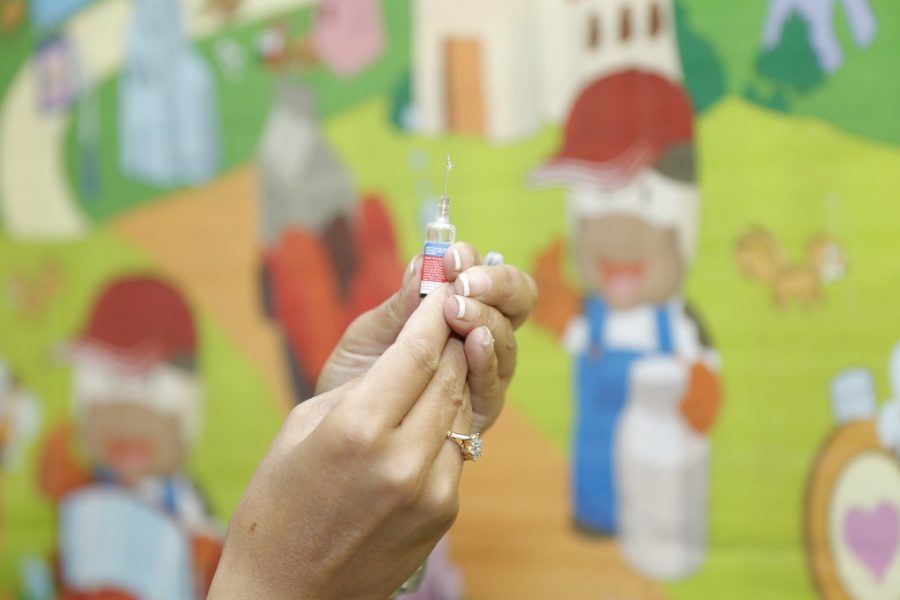Op-ed: A COVID-19 vaccine is almost ready. We need to convince the American public to take it.
“IPV vaccination” by Sanofi Pasteur is licensed under CC BY-NC-ND 2.0
A vaccine is almost ready to be distributed to the public, but significant social barriers remain.
December 2, 2020
When the coronavirus began to ravage the United States this past March, Americans were largely caught by surprise and had to play catch-up in order to slow the deadly virus’ spread. We needed a plan, and we did not have one.
The drastic lack of governmental precautions and public awareness led to a mind-numbing amount of suffering and death in areas like New York City. Crowded hospitals, the absence of adequate personal protective equipment and a panicked public turned the city into what resembled a warzone, with deserted streets and temporary field clinics set up in Central Park. In response, some politicians advocated for mask mandates, others opposed them, and unified public health messaging was thin on the ground. It cannot be emphasized enough that this mismanagement cost tens of thousands of American lives.
We all long for the virus to no longer threaten our way of life, and the answer to our prayers comes in the form of a vaccine. Pfizer recently announced that early analysis of its in-trial vaccine showed it to be more than 90 percent effective in preventing COVID-19, a positive development in the race to provide a cure. It is very likely that, within the next couple of months, Americans can begin to expect the heavily-anticipated rollout of COVID-19 vaccines. And when it comes to vaccine distribution, we as a country have a chance to learn from our past mistakes.
The turmoil we all have experienced since March, and the lack of early action to prevent it, will forever be a dark stain on U.S. history. The United States needed increased efforts by the government, — since Trump admittedly downplayed the severity of the virus as early as January — and to a slightly lesser degree, national media to proactively anticipate the pandemic and make the public aware of the virus’ disastrous potential. They both ultimately failed to do this.
Now, here we are. Eight months later, COVID-19 has claimed the lives of over 250,000 Americans, with over 10 million confirmed cases in the United States. Just in the last week, the United States shattered the record number of positive cases confirmed in one day, and then followed that up that next day by breaking the record again. As the winter season approaches, experts predict an increase in cases, hospitalizations and deaths. The immediate outlook looks bleak.
According to a September study by the Pew Research Center, 51 percent of Americans said they would definitely or probably get a vaccine to prevent COVID-19 if it was available today, and the other 49 percent say they definitely or probably would not get vaccinated. These statistics are frightening. To achieve herd immunity, experts project that 60 to 70 percent of the population needs to be vaccinated or otherwise have COVID-19 antibodies. In order to eradicate this disease, get our lives back on track and restart the economy, we must collectively agree to get vaccinated, united as Americans with a common purpose.
Federal, state and local governments, as well as national and local news media, must take an active role in ensuring public health through the creation of public awareness campaigns.
The beginning of the end of this pandemic starts once the public gains insight into the massive effort behind the creation of a vaccine, and how it will be distributed to them. A public awareness campaign should detail how the vaccine is administered, address safety concerns and risks and give logistical information about when and where to receive it. On top of that, compelling and factual messaging should be used to create broad public enthusiasm for vaccination. These messages might take the form of short digital advertisements, similar to the clips encouraging mask-wearing that CNN has been airing. If a media company is afraid to take a stance on vaccines, think about it this way: Any loss in ad revenue will be made up in public goodwill.
If there is a national media emphasis pushing for the public to take the vaccine, public confidence would increase and lead us closer to a world without the perpetual danger of COVID-19. The race to create the vaccine, dubbed Operation Warp Speed, is scientifically unprecedented and is a significant medical achievement. Development of a vaccine usually takes five to 10 years before it is approved for public use, but the scientific community created a safe and effective COVID-19 vaccine in mere months.
The more the public knows about the vaccine, the better. There should be an emphasis on the fact that the virus does not care about political parties — liberal or conservative, the virus kills indiscriminately. We should get vaccinated in order to be responsible citizens. Believing in and accepting a vaccine is the single safest way to achieve herd immunity, and we can do that together by trusting the science and listening to our leaders.
Vaccination should be similar to the notion of wearing a mask: If you do not wear one to protect yourself, then do it to protect the vulnerable people around you.
Lucas Cooperman is a second-year media and screen studies and journalism combined major. He can be reached at cooperman.l@northeastern.edu.







